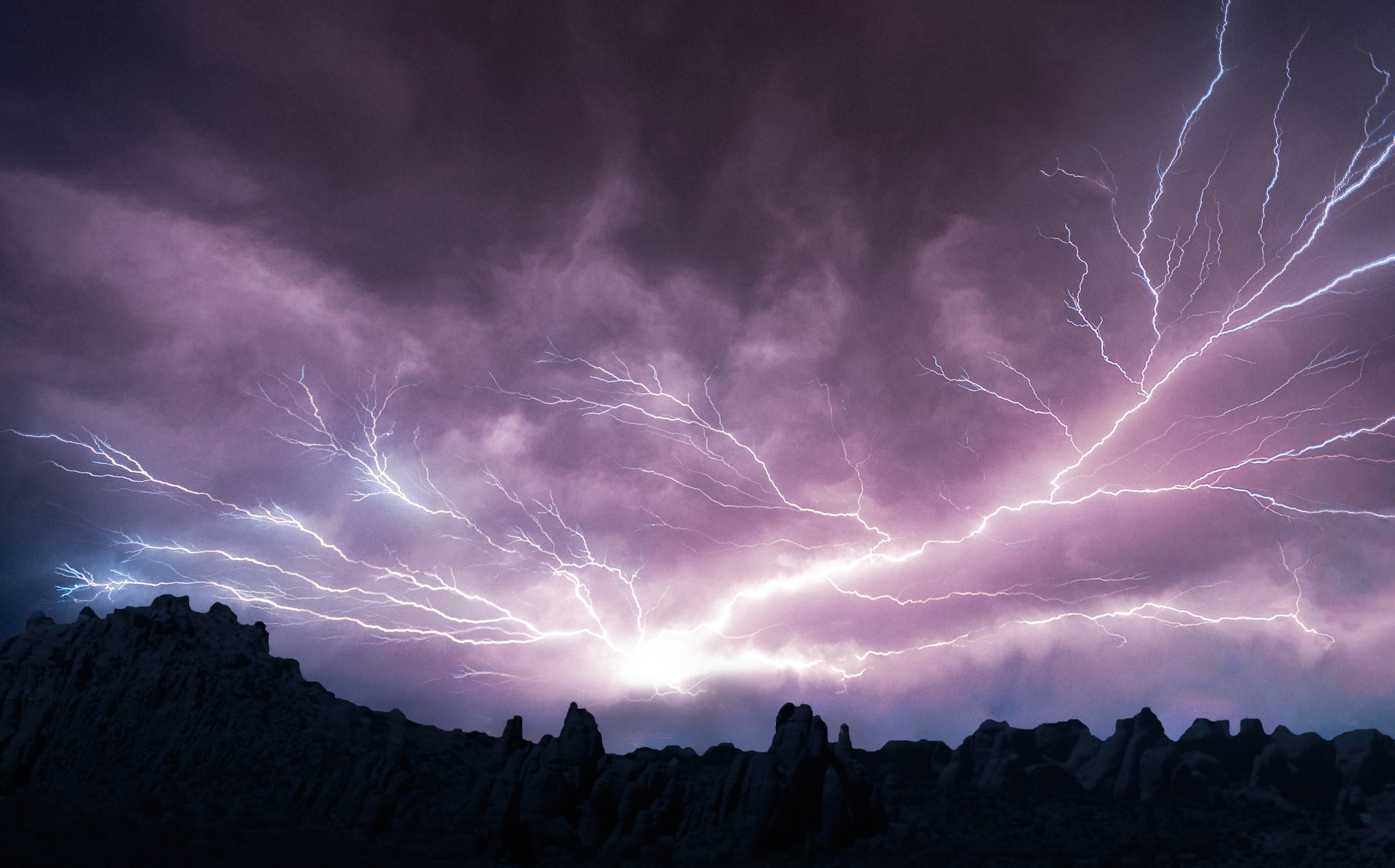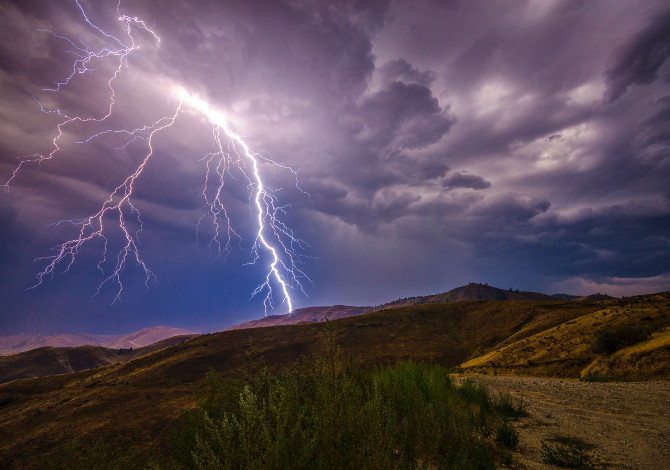And thunderstorm in the mountains it is a situation potentially fraught with dangers, and not just with regard to i lightning, which are the greatest but also the rarest risk that you can run in the mountains during a storm. In fact, a storm also always involves a sudden and drastic one lowering of temperatureswhich can be a serious problem if you are not dressed and equipped properly, can force you to stop until you are surprised by the coming of darknesswith inevitable problems to go back down to the valley or find shelter for the night, and can make it difficult to walk along the paths if you don’t wear shoes suitable for trekking in the mountains. For all these reasons it is really important to know what to do to predict and prevent a thunderstorm in the mountains and to know how to behave if one is taken by surprise by it.
Thunderstorm in the mountains: how to predict it
The first thing to do when planning a trip is check the weather forecast. It is true that by their nature storms can be both sudden and unpredictable, but in the summer season it is very probable that towards the late afternoon there will be thunderstorms caused by the collision of masses of warm air pushed upwards with others of colder air which they descend to the ground. Basically the thunderstorms are given by strong heating of the air at ground level, which begins to rise until it meets the cold air: this obviously occurs more towards the end of the day, when the ground has accumulated heat, than in the morning, and therefore already organizing a trip planning to return towards the middle in the afternoon is a good way to try to avoid dangers due to thunderstorms in the mountains. The weather forecasts are always to be checked and respected, but thunderstorms often escape mathematical models of weather forecastsreasons why it can be useful to learn to recognize the conditions that lead to the storm phenomenon.
It is true that these are typical summer conditions but on a day where it has been there since the morning sultry heat and no windtherefore still air, and in the sky they can already be seen little sheep clouds (do you know the proverb “sheep in the sky, pouring rain”?) it is very probable that the conditions will be created for a storm. The storm actually originates from another type of cloud, which is the cumulonimbus clouds, large clouds with sharp outlines, cauliflower-like bumps and a marked vertical development, so much so that they can usually go from 1000 meters up to over 10,000 in altitude. The cumulonimbus is composed of a mass of warm air pushed upwards and can meet masses of cold air coming from the flanks (in the case of cold front thunderstormswith the colder air creeping under the warmer one also triggering hail as well as rain, lowering of temperatures and lightning) or from above (and in the case of convective stormwhich has the characteristic of being very localized and being exhausted in an average short time, between half an hour and an hour).
In the presence of these cumulonimbus clouds in the sky and clouds rising up the sides of the mountain, if you are at altitudes above 2,000 metres, it is very probable that sooner or later a storm will break out, and therefore it is advisable to hurry and get in a safety condition.
Thunderstorm in the mountains: what are the risks?
The risks you run for a thunderstorm in the mountains are different and of different magnitude. Rain, hail and sudden drop in temperatures are potential risks, which become such if you are not suitably dressed and equipped. The same applies to any difficulty walking due to inadequate footwear. But the greatest danger, which can easily become a risk, is related to lightning, which can be deadly.
Lightning is essentially an electric discharge and is formed due to the potential difference between two nearby clouds or between the top and bottom of the same cloud. Exist two types of lightning: those from cloud to cloud, which could be called “horizontal”, and those which discharge to the ground, therefore “vertical”. Lightning manifests itself with the emission of a violent light in a very short time (the so-called flash, which has a temperature of 30,000 degrees and proceeds at a speed of 10,000 km/sec.) and the consequent roar, given by the sudden heating of the air , called thunder.
There are some demonstrations that can help figure out how far away the storm is and if lightning is about to strike in our vicinity. Since the speed of sound is about 1 km every 3 seconds, dividing the number of seconds between lightning and thunder by 3 gives us an idea of the distance at which the storm is located and, over time, whether it is getting closer or further away. If you only see lightning but hear no thunder, the storm is at least 30km away.
Luckily lightning that discharges to the ground is a small percentage of all the lightning that comes from a storm, but if you are in the mountains they are certainly the most dangerous ones. There are some warning signs that can let us know if lightning is about to strike in our vicinity. Self the air “fries”if pylons and electrical cables hum louder than usual, if hair and hair are electricin the sense that they stand up, or you feel tickling or tingling, or even if you see the St. Elmo’s fireswhich are bluish electric discharges that are released near sharp metal objects (a pylon, a summit cross, metal poles, antennas, etc.) then there is a high risk that lightning is about to discharge nearby and it is necessary to take the appropriate precautions.
How to shelter from lightning during a thunderstorm in the mountains
Sheltering from lightning is the most important thing to do in the event of a thunderstorm in the mountains, but it is neither simple nor trivial. Essentially it is about avoid being a “tip” that attracts lightningbut this means many things that are also very different from each other.
First you need to get away from anything that represents an isolated tip or leads us to be: away from the peaks, away from the crests, away from spiers and boulders but also away from isolated trees and also away from the clearings, in which we are nothing but a thing that points upwards and attracts lightning.
If it is in a group it is better to split up (a group of people produces hot air which, rising upwards, generates a sort of corridor that attracts lightning) and if you are in a large clearing, better crouch on the ground (feet close together, head inside the knees) isolating oneself from the ground (you can sit on the backpack, therefore getting up a little from the ground). If there is a forest, it may be a good solution to slip inside it, however avoiding standing next to tall trees that point towards the sky and perhaps trying to stay in the thick of the lower plants.
Must immediately move away from any metallic object: therefore away from pylons, poles and high voltage cables but also from the structures of via ferratas, from metal Tibetan bridges, from chains and any metal object. Even those I’m wearing (carabiners, ice axes, trekking poles) should be thrown as far as possible because they conduct electricity. It would also be good to turn off your cell phone and any other electronic device (but these could be useful for calling for help, if necessary).

Try to avoid becoming a “point” yourself and, if you are in an open space, place yourself as close to the ground as possible, crouch down, making sure that the least portion of your body is in contact with the ground. The ideal is to sit on the backpack (dry), isolating the body as much as possible from the ground and surface currents which are propagated after a lightning discharge. Even more ideal would be to find a hollow or small lowering of the land with respect to the remaining surface. If you have a thermal blanket with you, absolutely avoid using it for shelter because it strongly attracts electric shocks.
Beware that even climbing ropes can conduct electricity, as well as thermal sheets and stones: for this you must stay away from protruding boulders and stones, move away from the wall where you are possibly climbing and in any case not find shelter under a vertical wall. For the same reason, even a cave could be subtly very dangerous: it is true that it shelters from the water but it could conduct the electric discharge of lightning, so it would be necessary to isolate oneself from the bottom (sitting on the backpack, as mentioned above) and stay at a safe distance from at least a couple of meters from its walls, beside you and above your head.
When you can feel safe during a thunderstorm in the mountains
The answer would be: basically never. However, if you have taken all the above precautions you have really minimized all the risks, and you can expect it to end in relative peace. If the storm is far enough away (say about ten km, or the time of 30 seconds between lightning and thunder) a safe shelter can be found in reasonable safety. And when the storm has been gone for half an hourand no more thunder is heard, it means that there is no danger of unexpected lightning either.
Photo by Frank Cone from Pexels
Advertising
